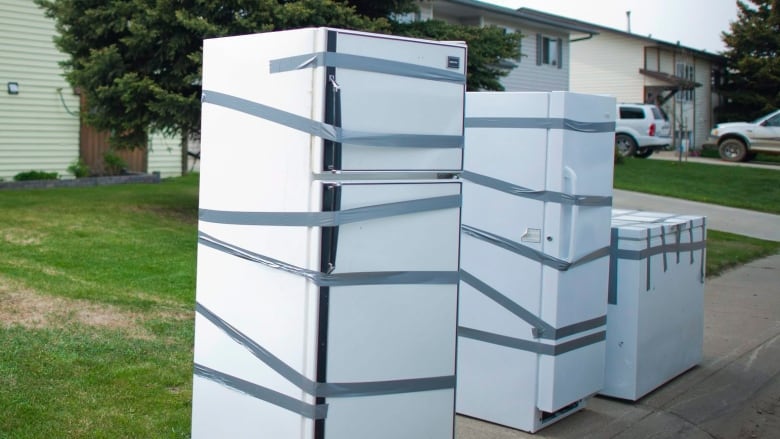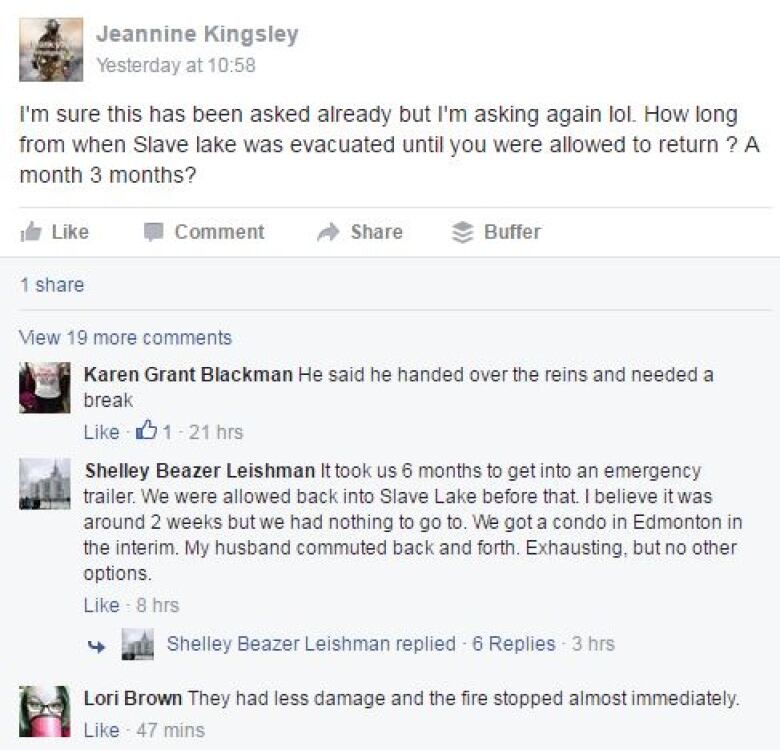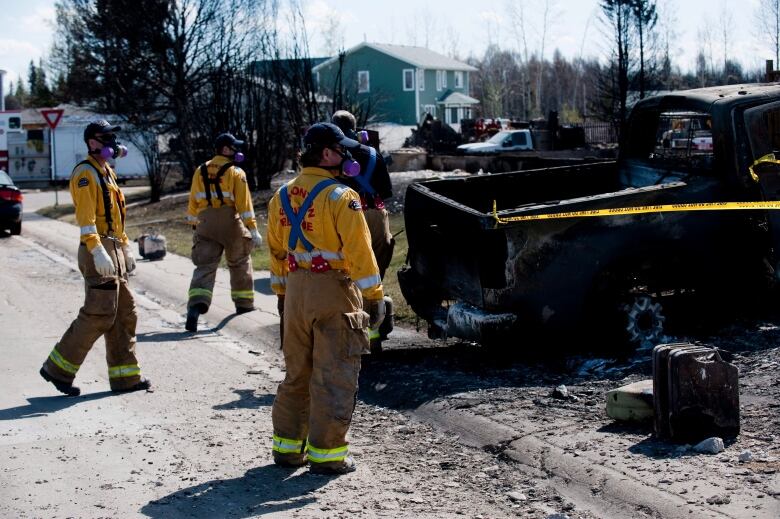Fort McMurray recovery: lessons from the Slave Lake rebuild
'Be patient. It is going to take a long time to rebuild and you want to do it right.'

Thousands of refrigerators were stacked three, four, and five units high, forming a ramshackle wall that stretched across an Alberta landfill.
The refrigerators belonged to the residents of Slave Lake, forced to flee a wildfire that tore through their corner of Alberta's boreal forest, forcing residents out of their homesfor two weeks in 2011.
Power in much of Slave Lake shut off during that time, meaning jugs of milk, tubs of yogurt, and containers of marinating meat were left to rot in the kitchens of people who had fled, making them unsalvagable. With 2,700 homes in Slave Lake, there were thousands of appliances to turf.
The city advised residents to duct tape them closed and leave them at the curb.
It was one of the first steps in the long road to recovery for the pretty community, located about 300 kmnorth of Edmonton. Town officials say about 95 per cent of Slave Lake is rebuilt. It was a process that required patience, organization and the disposal of tremendous piles of waste created by a wildfire that burned through residential neighbourhoods that people were determined to rebuild.
"Just getting rid of all of that waste was a huge problem," said Brian Vance, chief administrative officer for the Town of Slave Lake.
Slave Lake advice for Fort McMurray
As efforts in Fort McMurray move from emergency response to recovery, the experiences of Slave Lake have become a comparison for those wondering what reconstruction might look like. The recovery manager for Slave Lake has been hired by the province to advise the situation in Fort McMurray.
A Facebook group called "Residents of Slave Lake Lend Support/Advice" has more than 7,000 members, with Fort McMurray residents postingquestions daily about insurance companies and rebuilding which are being answered by Slave Lake residents.

The official recovery guide is a full publication by the Town of Slave Lake and the Northern Alberta Development Council called Wisdom Gained, which outlines the steps inrebuilding a community after a wildfire.
Slave Lake was a community of about 6,000 residents, where roughly 400 structures were razed. The fire occurred in economic boom times. Fort McMurray is the capital of the oilsands region, with 90,000 residents, sprawling oilsands plants to the north, and an estimated 2,400 buildings destroyed. The situations are different, but some advice remains the same.
"The main piece of advice is to plan a lot and keep people informed," said Vance. "Be patient. It is going to take a long time to rebuild and you want to do it right."
Resentment can linger
After the fire swept through Slave Lake, entire streets were reduced to grey ash and rubble. While the inferno that had consumed much of the town was extinguished, occasional flare-ups in the basements of destroyed homes continued.
That led to one of the first, and perhaps most poignant, mistakes in Slave Lake reconstruction. Before residents returned, crews used backhoes to clear out loose items and rubble in charred basements to limit the risk of small fires.
Many residents resented that these things had been removed, and that they were unable to sift through what might have survived the flames. The move contradicted one of the key rules that Vance shares for redevelopment: tell residents what you're doing, otherwise resentment lingers.
But at the same time, town officials were preparing for massive demolition. The town hired an engineer to oversee the project, while coordinating insurance companies, a waste management firmand utility companies to work as one team.
"The biggest decision early on was what to do about the clearing out of the town," said Vance.

Contract crews worked methodically through the streets, first using giant magnets to collect molten metal and sharp appendages of steel. A separate crew collected concrete, and piled it into a mountain of material that would later be crushed for gravel. Then more workers hauled away wood debris that was put through a chipper, creating golden-coloured mounds that reached as high as the houses that once stood on the streets.
The landfill at Slave Lake received as much waste in four months as it usually does in three years.
Burned areas were fenced off when residents returned. Those who wanted to enter needed permission and proof they had once lived there.
Returning to city without landmarks
For Nicola Ramsey one of the strangest things about returning to Slave Lake was the lack of landmarks. As a 26-year resident of the town, she would look for a house of a certain colour or an ornament on a particular lawn. Without those markers, it was hard to know what street she wason.
"The first feelings of normal came when the first people were allowed to start building their houses," she said, adding that happened about six months after the fire. "But I honestly don't think I felt it was close to normal for a year, or a year-and-a-half, when you started seeing whole streets of houses."
Ramsey's house wasn't destroyed in the fire and she and her husband had steady employment as teachers in the town. They didn't think about not returning. They followed advice given by emergency management officials, who warned them to bring three days worth of food for their return and to purchase a new refrigerator.
Even a couple of weeks after the fire, residents were still sharing their stories of escape and trying to piece together the tremendous events that unfolded on May 15, 2011.
Ramsey started sifting through her text messages, Facebook posts, and photos and put them in sequence. She figured others might want to do the same. That turned out to be the start of a book called The Sky Was On Fire, a collection of stories and photos about the Slave Lake fire, written by Ramsey and three other residents.
More than 5,000 copies sold, with proceeds donated to local charities. The town has changed in the five years since the fire. With a sizeable semi-permanent population of oil and gas workers, Ramsey previously wouldn't have called the community "close knit."
"But I feel like after the fire there was more of a sense of community," Ramsey said. "And I feel the people here are a bit more feisty. If they feel something is not right, they're not just going to sit around quietly about it, they're going to make a bit of noise."
Temporary housing essential
Slave Lake Mayor Tyler Warmanreiterated that it was with much patience that the town rebuilt.
"I don't think our community has suffered from a mass exodus of people," said Warman, who was a town councillor and volunteer firefighter at the time of the blaze.
"I think the biggest reason for that was the temporary housing. We lobbied hard for that and the province came to the plate. If it hadn't been for that, I think it would have been a totally different scenario...I might have questioned if I'd still be here."
Warman said the town's push for two subdivisions of temporary housing was critical to ensure people could at least return to their community, if not to their homes.At the time, the vacancy rate was close to zero per cent and then a surge of construction workers arrived for reconstruction.
"If people are out of their community for months, they're growing roots somewhere else."
Everyone knows someone who has left, either immediately after the fire or in the following years. But the actual population change in Slave Lake is more difficult to pin down.
The federal census was just under way when the wildfire happened. Anecdotally, observers say the population surged during reconstruction but has dropped again as the oil and gas industry slumps. The next census results are expected early next year.
Community spirit stronger
A week after the Fort McMurray fire, at least one company is filling 500 jobs on behalf of a major disaster recovery firm that is preparing to enter the oilsands capital.
The company hosted a hiring fair in Edmonton this week that attracted hundreds and has booked 1,400 beds for workers in camps near Fort McMurray.
It is the very beginning of a rebuilding process that will take years to complete.
Warman said there was a "lot of grumbling" in the first six months after the Slave Lake fire. People were stressed and dealing with insurance companies, a difficult and new experience for many. There were some fly-by-night builders and sometimes people just needed to vent.
The town council had hundreds of decisions to make every day, and the scrutiny was intense. It changed the community.
"Now, the spirit is stronger. There's a bigger sense of community," said Warman.
"There's a bigger sense of co-operation between business, governmentand working with First Nations. Now there's less griping because in the scheme of things, some things aren't a big deal. If we can survive (the fire), we can survive anything."
With files from the Canadian Press












_(720p).jpg)


 OFFICIAL HD MUSIC VIDEO.jpg)
.jpg)



























































































